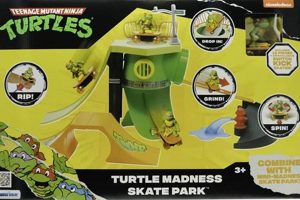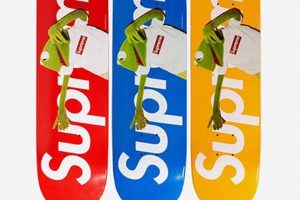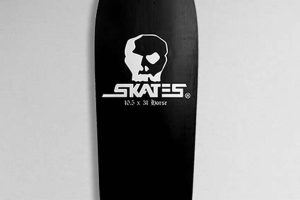A skateboarding platform manufactured by Toy Machine, a deck provides the surface upon which a rider stands. Constructed typically from multiple layers of laminated maple wood, it forms the foundational component of a complete skateboard. Examples include decks featuring distinct graphics and varying dimensions to cater to different riding styles and preferences.
The rigidity and resilience of these platforms are critical for executing tricks and maneuvers. They offer a balance between impact absorption and responsiveness, influencing board feel and control. Historically, the brand has been associated with innovative designs and durable construction, contributing significantly to skateboarding culture and performance standards.
Further discussion will address specific deck features, graphic design trends, and the selection process for riders of varying skill levels. The impact of deck size and shape on riding style will also be analyzed. Understanding these elements enables informed decisions when choosing equipment.
Selection and Maintenance
Optimizing performance and longevity necessitates careful attention to both the selection and subsequent care of skateboarding equipment. The following guidelines provide a framework for informed decision-making.
Tip 1: Assess Skill Level and Riding Style: Beginner riders may benefit from wider platforms, offering increased stability. Advanced skaters often prefer narrower options for enhanced maneuverability. Riding discipline, whether street, park, or transition, will influence optimal dimensions and concave.
Tip 2: Consider Deck Material and Construction: The quality of maple used and the lamination process directly impact durability and pop. Seek decks constructed from North American maple for superior strength. Check for consistent ply adhesion to prevent premature delamination.
Tip 3: Evaluate Deck Dimensions: Width is a primary consideration. A wider platform provides more foot space and stability, while a narrower one facilitates quicker rotations. Length also influences control, with longer decks offering greater stability at higher speeds.
Tip 4: Inspect Concave and Kick: Concave affects foot placement and board feel. Deeper concave offers a more pronounced pocket for locking in during tricks. Kick angle influences pop and ollie height. Select a concave and kick that complements riding style.
Tip 5: Maintain Hardware Integrity: Regularly inspect trucks and hardware for looseness. Tighten axle nuts and kingpins as needed to prevent wobble and maintain stability. Replace worn bushings to preserve turning responsiveness.
Tip 6: Protect from Moisture and Extreme Temperatures: Exposure to water can weaken wood and cause warping. Store the platform in a dry environment away from direct sunlight and extreme temperatures to prevent damage and extend its lifespan.
Adhering to these principles will contribute to an enhanced skateboarding experience through improved performance and extended equipment life.
The subsequent section will address specific applications of these principles in various skateboarding contexts.
1. Construction Materials
The selection of appropriate construction materials is paramount to the performance and longevity of skateboarding platforms. The materials used directly influence the deck’s strength, flexibility, and overall feel, thus dictating its suitability for various riding styles and skill levels. For the brand mentioned, material choice is a key factor in defining its product characteristics.
- North American Maple Ply
Hard rock maple, sourced primarily from North America, constitutes the industry standard for skateboarding deck construction. Its high density and fine grain provide exceptional strength and resistance to splitting. The number of maple plies, typically seven, affects deck thickness and stiffness. Decks constructed from inferior maple variants exhibit reduced durability and diminished pop.
- Adhesives
The adhesive used to bond the maple plies together is critical for structural integrity. High-quality epoxy resins provide superior bonding strength and water resistance compared to cheaper alternatives. Insufficient or inconsistent adhesive application can lead to delamination, compromising deck performance and safety. The type of glue and its application process significantly impact overall product lifespan.
- Reinforcement Materials
Certain decks incorporate reinforcement materials, such as carbon fiber or fiberglass, to enhance strength and torsional rigidity. These materials are strategically placed within the maple plies to provide added support in high-stress areas. The inclusion of such reinforcement elements can increase deck cost but offers potential benefits in terms of durability and pop retention.
- Wood Grain Orientation
The orientation of the wood grain within each maple ply influences the deck’s flex characteristics and resistance to warping. Alternating the grain direction in adjacent plies creates a balanced structure that distributes stress evenly. Deviations from proper grain orientation can result in uneven flex patterns and increased susceptibility to damage.
The combined effect of these material choices directly impacts the deck’s performance characteristics. The mentioned brand relies on premium materials and meticulous manufacturing processes to deliver products that meet the demands of skateboarders across diverse skill levels and riding styles. Understanding these material considerations allows consumers to make informed purchasing decisions based on their specific needs and preferences.
2. Deck Dimensions
The dimensions of a skateboarding platform, specifically length and width, are critical design parameters influencing the performance characteristics of any such product. For platforms produced by Toy Machine, dimensional specifications directly affect board feel, stability, and maneuverability. A wider deck, for example, provides increased stability and foot space, beneficial for beginner riders or those focused on transition skating. This increased surface area contributes to a more secure stance, enabling controlled movements during grinds and aerial maneuvers. Conversely, a narrower profile facilitates quicker rotations, a desirable trait for technical street skating. The longitudinal dimension impacts wheelbase, influencing turning radius and overall board responsiveness.
Toy Machine’s product line typically offers a range of dimensional options to cater to diverse rider preferences and skill levels. For instance, a 7.75-inch wide deck might suit younger or smaller riders, while an 8.25-inch deck or wider would be preferred by larger individuals or those seeking enhanced stability. Deck length also varies, with longer decks generally favored for stability at higher speeds and shorter decks offering increased agility. These dimensional variations reflect the manufacturer’s commitment to accommodating a broad spectrum of skateboarding styles.
In conclusion, deck dimensions are not arbitrary; they are carefully considered design elements that dictate a platform’s suitability for specific riding styles and skater physiques. Understanding the interplay between deck width, length, and wheelbase enables skaters to make informed purchasing decisions, optimizing their performance and enhancing their overall skateboarding experience. This is a crucial element of selecting a proper and useful toy machine skate deck.
3. Concave Profile
The concave profile is a critical design element integrated into skate decks, including those produced by Toy Machine. It refers to the transverse curvature of the deck’s surface between the edges. This curvature influences foot placement, board feel, and the execution of various skateboarding maneuvers. Deeper concaves generally provide enhanced grip and control, facilitating more aggressive riding styles and technical tricks. Conversely, shallower concaves offer a more forgiving feel, often preferred by beginners or riders prioritizing stability over intricate maneuvers. The specific concave profile directly affects a skater’s ability to lock their feet onto the board, enabling more precise control during ollies, kickflips, and other complex tricks. Therefore, understanding the nuanced relationship between concave depth and individual riding preferences is crucial for optimizing performance.
Toy Machine offers skate decks with varying concave profiles to cater to diverse skating styles. Some decks may feature a mellow concave, providing a stable and comfortable platform for cruising and basic tricks. Other decks incorporate a more pronounced concave, enhancing control and responsiveness for advanced skaters executing technical flip tricks and rail maneuvers. Examining the specifications of different Toy Machine deck models reveals a deliberate effort to provide options that accommodate a wide range of skill levels and preferences. Real-world examples demonstrate that skaters who select a deck with a concave profile aligned with their riding style experience improved board feel and control, leading to enhanced performance and progression.
In summary, the concave profile is an essential determinant of a skateboard deck’s performance characteristics. Its influence on foot placement, board feel, and maneuverability cannot be overstated. Toy Machine’s commitment to offering a range of concave profiles underscores the brand’s dedication to providing skaters with the tools necessary to excel in their chosen discipline. Recognizing the significance of this design element enables informed purchasing decisions, ultimately contributing to a more rewarding skateboarding experience. Challenges remain in quantifying the subjective aspects of board feel, highlighting the importance of test-riding various decks to determine optimal concave preferences.
4. Graphic Design
Graphic design serves as an integral component of skate decks, influencing brand identity and consumer appeal. For brands like Toy Machine, graphics are not merely aesthetic embellishments; they are a deliberate expression of the company’s ethos and a key element in its marketing strategy. Distinctive visuals, often characterized by bold colors, stylized characters, and subversive themes, distinguish decks within a competitive market. The selection of a particular graphic can reflect a skater’s personal style, aligning them with a specific brand identity or subculture within skateboarding. The evolution of deck graphics mirrors trends in art, music, and broader cultural movements, rendering them a visual timeline of skateboarding’s history. Examples include Ed Templeton’s iconic illustrations for Toy Machine, which have shaped the brand’s image and fostered a loyal following. The choice of colors, typography, and imagery can affect a deck’s perceived value and its ability to resonate with target demographics. Understanding these elements enables informed product selection.
The application of graphic design extends beyond surface aesthetics. The printing process itself, whether screen printing, heat transfer, or digital printing, impacts image durability and clarity. High-quality printing techniques ensure that the graphic remains intact despite the wear and tear associated with skateboarding. Moreover, the placement of graphics on the deck is a deliberate design decision. Strategic positioning can enhance visual appeal while minimizing interference with foot placement or performance. Some graphics incorporate textured elements or grip tape patterns, blurring the line between aesthetics and functionality. Collaboration with artists and designers is a common practice in the skateboarding industry, resulting in limited-edition decks that command higher prices and appeal to collectors. These collaborations underscore the cultural significance of deck graphics and their role in fostering creativity within the skateboarding community.
In summary, graphic design constitutes a critical aspect of skate decks, influencing brand perception, consumer choice, and the overall aesthetic landscape of skateboarding. The integration of compelling visuals, durable printing techniques, and strategic placement elevates a deck from a mere piece of equipment to a form of self-expression and a cultural artifact. Challenges remain in predicting graphic design trends and ensuring that deck aesthetics continue to resonate with evolving skater preferences. Nevertheless, the ongoing interplay between graphic design and skateboarding underscores the power of visual communication in shaping identities and driving consumer behavior.
5. Brand Legacy
The enduring influence of a brand significantly shapes consumer perception and product value, particularly within specialized markets such as skateboarding. Toy Machine’s decades-long presence has established a recognizable aesthetic and a reputation for quality that directly impacts the desirability of its skate decks. This legacy is not merely a historical footnote; it actively informs consumer expectations regarding durability, design, and performance. The brand’s consistent association with innovative graphics and endorsement by influential skaters solidifies its position, creating a self-reinforcing cycle where historical credibility drives contemporary demand. For instance, a deck featuring artwork reminiscent of the brand’s early 1990s designs resonates with established skateboarders, while newer graphics attract a contemporary audience, demonstrating the enduring power of brand recognition.
The practical effect of this brand legacy manifests in pricing strategies, market positioning, and customer loyalty. Decks bearing the Toy Machine logo often command a premium compared to lesser-known brands, reflecting the perceived value associated with its history and reputation. Furthermore, the company’s established distribution networks and marketing campaigns leverage this brand recognition to maintain market share and introduce new products effectively. The commitment to quality and design, cultivated over years of operation, translates into customer confidence, fostering repeat purchases and positive word-of-mouth referrals. The legacy, therefore, functions as a tangible asset that underpins the brand’s current and future success.
In summary, Brand Legacy is not a passive element but an active driver of value and consumer behavior in the skateboarding market. Its influence is demonstrably reflected in the perception, pricing, and demand for Toy Machine skate decks. While contemporary trends and innovative technologies contribute to product development, the underlying foundation of brand credibility remains a crucial factor in the company’s continued success. The challenge lies in maintaining this legacy while adapting to evolving consumer preferences and technological advancements, ensuring that the brand’s historical significance remains relevant in a dynamic market landscape.
Frequently Asked Questions
The subsequent section addresses common inquiries regarding skateboarding platforms, specifically those manufactured by Toy Machine. This information is intended to provide clarity on critical aspects of selection, maintenance, and performance.
Question 1: What factors determine the optimal deck width for a skateboard?
Deck width selection depends primarily on the skater’s foot size and riding style. Larger feet generally benefit from wider platforms for enhanced stability. Technical street skaters often prefer narrower decks for increased maneuverability during flip tricks. Beginner skaters may find wider decks more forgiving due to the increased surface area.
Question 2: How does concave profile affect skateboarding performance?
Concave influences foot placement and board feel. Deeper concaves provide a more pronounced “pocket” for locking in feet during tricks, facilitating greater control and responsiveness. Shallower concaves offer a flatter, more stable platform suited for cruising and less technical maneuvers.
Question 3: What is the typical lifespan of a skateboarding platform?
Deck lifespan varies depending on frequency of use, riding style, and the skater’s weight. Under normal conditions, a deck may last several weeks to several months. Cracking, delamination, and loss of “pop” are indicators that a replacement is necessary.
Question 4: How should skateboarding decks be stored to prevent damage?
Storage in a dry, temperature-controlled environment is recommended. Exposure to excessive moisture can cause warping and delamination. Avoid prolonged exposure to direct sunlight, as UV radiation can degrade the wood and graphic.
Question 5: What is the purpose of grip tape on a skateboard deck?
Grip tape provides the necessary friction between the skater’s shoes and the deck surface, enabling control and stability. The abrasive surface of grip tape prevents slippage during tricks and maneuvers.
Question 6: How does the construction material of the skateboard deck effect skating?
The most common, and arguably best, material for a skate deck is North American Maple Ply. Maple is a hard, strong wood that is able to take the beating it will endure with skating. Also, the way the wood is pressed and glued will also play a huge factor.
Consistent maintenance and informed purchasing decisions contribute to an enhanced skateboarding experience and prolonged equipment life.
Further insights will be provided in the following section.
Conclusion
This exploration has elucidated the critical attributes of a toy machine skate deck, from the selection of materials and dimensional considerations to the influence of concave profiles, graphic design, and brand legacy. Understanding these elements empowers skateboarders to make informed purchasing decisions, optimizing their equipment for enhanced performance and longevity. A comprehensive grasp of these aspects fosters a deeper appreciation for the complexities inherent in skateboarding equipment design and manufacturing.
The continued evolution of skateboarding technology and design principles suggests a future where skate decks are even more finely tuned to individual rider preferences. As advancements in materials science and manufacturing processes emerge, further improvements in deck durability, responsiveness, and customization are anticipated. Skaters are encouraged to remain informed about these developments, enabling them to select equipment that best suits their evolving needs and aspirations, contributing to the ongoing progression of skateboarding as a whole. It is highly recommended to always keep up with any changes to skateboard technology, as it may assist you on your way to greatness in skating.







